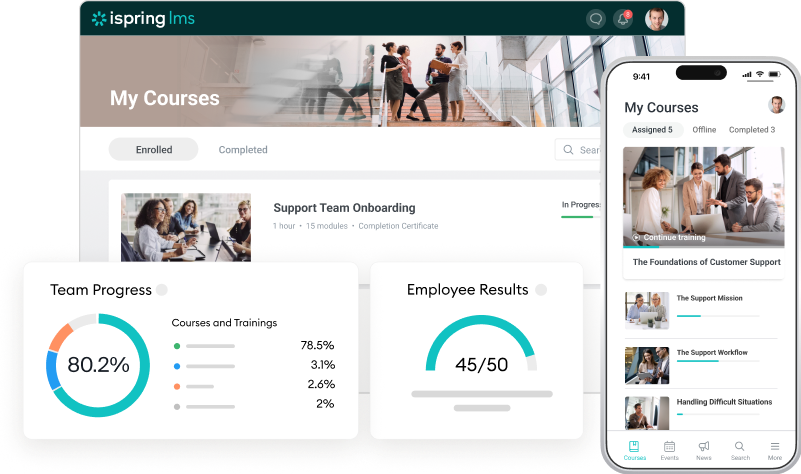The 16 Best Learning and Development (L&D) Tools

Intelligent learning and development tools can be game-changers for your business. With the right solutions, your teams will stay sharp and ready to take on new challenges, whether they’re expanding their skills or adapting to shifting company goals.
If you’re focused on upskilling your team or want to make the most of corporate employee training, these L&D tools are the right place to start. In this article, you’ll discover options that help you pinpoint current skill levels and build knowledge for future success.
What are Learning and Development (L&D) tools?
L&D tools are platforms or software solutions that help organizations manage employee training, upskilling, and professional growth. They include platforms for creating, delivering, and tracking training programs, thus ensuring that learning is not just accessible but also measurable.
In simple terms, these tools give companies the digital infrastructure to build a culture of continuous learning.
What types of Learning and Development tools exist?
Effective L&D systems usually combine several tool types like Learning Management Systems (LMSs), course authoring tools like iSpring Suite AI, and analytics and reporting tools. Together, these L&D tools form an integrated ecosystem that supports every stage of continuous learning, from creation to impact measurement.
The Benefits of Learning and Development Tools
Many people see learning and development tools as a way to help meet the company’s goals through training, and they’re not wrong. But those who use L&D strategically know that its true value goes much further. When woven into the fabric of daily business, learning drives culture, encourages collaboration, and even opens new avenues for growth.
With the right approach, your L&D program becomes more than a support function; it becomes a catalyst for lasting success.

Identifying skill gaps
When L&D professionals put data to work, they do more than tick boxes — they create a clear picture of each person’s strengths and growth areas. With analytics and performance tracking, you’ll pinpoint where skills need a boost, understand feedback, and see how people actually perform daily.
It’s not just about collecting numbers. Smart tools like LMSs and AI analytics make it easier to spot patterns across teams and departments, so you don’t just react — you get ahead. These insights help you build targeted, relevant initiatives that address what actually matters in your business. Real impact starts with real understanding, and with these solutions, you get both.
Creating training programs and content
To close skill gaps, HR teams offer courses, workshops, and a variety of learning resources. Authoring tools empower them to turn complex topics into interactive, easy-to-follow personalized learning paths.
Equally crucial is making sure that learning is accessible to everyone, regardless of their needs. Most modern authoring platforms support this by allowing teams to quickly convert PowerPoint presentations into engaging eLearning modules, create immersive simulations, and much more.
Training employees and sharing knowledge
Modern corporate learning comes in many forms: from traditional classroom sessions and virtual instructor-led training to self-paced online courses, immersive simulations, and microlearning modules. Each format serves a specific purpose: workshops build teamwork, while digital courses support continuous, on-demand learning.
Collaborative learning platforms take this further by making knowledge sharing easy and engaging across teams. Employees can exchange ideas, collaborate on projects, and contribute their expertise to the company’s growing knowledge base.
Building connections and creating communities
Most LMS platforms make group learning easy with a simple group creation process. This feature helps employees stay connected, share ideas, and collaborate on solving challenges in real time. Instead of being a one-off event, your learning programs become ongoing exchanges.
As these groups grow, they form a powerful internal network of mentors and peers — a strong foundation for a sustainable learning culture. Over time, this community can extend beyond your company to include partners and customers, as The iSpring Club does. Members of this club gain access to a professional community where they can advance their careers by developing new skills and gaining practical experience.
The List of TOP L&D tools
Now, it’s time to look at the available solutions and choose the ones that will definitely grow your business.
| Tool | Best for | Type |
| 1. iSpring Suite AI | Easy AI-powered content authoring. No language barriers, easy creation of images and voices, and smart course structure generation. | Course authoring tool |
| 2. Articulate Storyline 360 | Creators with a higher level of technical expertise. | Course authoring tool |
| 3. Adobe Captivate | The collaborative course creation process. | Course authoring tool |
| 4. iSpring LMS | Creating a meaningful learning experience and tracking training effectiveness. | A comprehensive learning management system (LMS) |
| 5. TalentLMS | Making training programs to sell them outside the company. | Learning management system (LMS) |
| 6. D2L Brightspace LMS | Companies that are already using many standalone tools. | Learning management system (LMS) |
| 7. Valamis | Companies that will benefit from both buying course content and creating courses from scratch. | Learning experience platform (LXP) |
| 8. Stream LXP by Learning Pool | Getting recommendations based on established goals. | Learning experience platform (LXP) |
| 9. NovoEd | Collaborative learning and knowledge application. | Learning experience platform (LXP) |
| 10. iSpring Cloud AI | AI-assisted creation of simple courses that can be built individually or as a team. | Micro-learning platform (MLP) |
| 11. Absorb Amplify | Ready-made content that users can consume right away. | Micro-learning platform (MLP) |
| 12. SC Training (formerly EdApp) | White labeling of existing platform content. | Micro-learning platform (MLP) |
| 13. Microsoft Teams | Companies of all sizes that need as many as 20,000 seats in a virtual learning session. | Virtual instructor-led training (VILT) tool |
| 14. WebEx by CISCO | Organizations that want enhancement features like real-time translation. | Virtual instructor-led training (VILT) tool |
| 15. Slack | Highly secure messaging that can be divided into different threads. | Communication tool |
| 16. Workplace by Meta | Conducting learning conversations in a virtual space that feels a lot like Facebook. | Communication tool |
What Are the Different Types of Learning and Development Platforms?
The choice of L&D tools depends heavily on the unique learning needs of your trainees. To help you navigate these options, we’ve grouped some of the most common types together to give you a clear starting point.
Course authoring tools
eLearning authoring tools make your courses more interactive by fully immersing employees in every lesson for a richer learning experience. These tools let you transform raw content into SCORM-compliant courses, create engaging presentations, record voiceovers, and add interactive elements that boost learner engagement and retention.
Learning management systems (LMSs)
A learning management system is essential for a smooth online training process. It lets you handle everything in one place: upload or create interactive content right inside the platform; add learners and assign roles easily, whether via import or integration; enroll users and deliver training online; track employee progress; and provide assessments to measure outcomes. This all-in-one approach simplifies training management and helps keep your team on track.
Also read → Best Corporate Learning Platforms
Learning experience platforms (LXPs)
Learning Experience Platforms (LXPs) offer more freedom for skill development, making them a strong alternative to traditional LMSs. They provide similar functions, like monitoring progress and uploading course content, but go further by fostering a culture of learning through personalized learning paths, gamification, and social learning. This approach keeps employees motivated to continuously upgrade their skills.
Micro-learning platforms (MLPs)
They’re ideal when you don’t need the heavy features of LXPs or LMSs. They’re perfect for quick, focused tasks like compliance training, allowing you to deliver engaging micro-courses and quizzes that provide essential information swiftly.
Virtual instructor-led training (VILT) tools
These tools remove barriers to effective live virtual training. While common videoconferencing tools like Zoom and MS Teams are popular, they often lack crucial features like progress tracking and content management, which specialized VILT platforms provide.
Communication tools
Communication tools are vital for meaningful collaborative learning. They offer a dedicated space for learners to share insights, discuss course content, and interact with peers and instructors, enhancing engagement and knowledge retention.
Now, we’ll provide more detailed information on the tools that we’ve mentioned.
The Best Learning and Development Platforms in 2026
Price: $1,290 USD/author/year
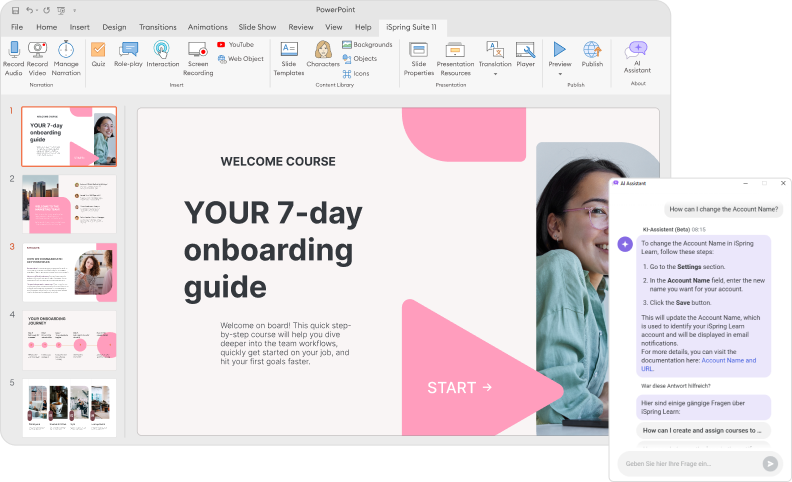
iSpring Suite AI is one of the best training and development tools out there if you want to create engaging professional courses right in PowerPoint. With its new AI capabilities, you can build a course plan or create a new course in a snap, add interactive dialogues or quizzes. Also, you can still import your PowerPoint slides into iSpring quickly or make your own course presentation from scratch.
What else can you look forward to when using iSpring Suite AI?
- Great creative capabilities. iSpring AI helps bring your ideas to life: you can quickly generate any content from text to outline or interactive quizzes and images.
- SmartAI support assistant. This feature will provide user help quickly, and you can make a request using any language. The AI help is easy to find: it’s right in your PowerPoint iSpring Suite tab.
- Assessments. How well did the learners absorb the material? You can find out using interactive assessments. iSpring AI offers 14 different types of such quizzes, from multiple-choice questions to a game in which you need to place items on shelves in the correct order.
- Screencasts and videos. Give your employees access to your expert instructional videos using this provider’s native video studio. The solution offers all the necessary video editing capabilities.
- Dialogue simulations. With iSpring Suite AI, you can develop communication-focused modules or courses. Create your own characters or choose the templates for interactive role-play simulations that will help your trainees develop conversation skills.
- Interactions. You can enrich your presentation with 14 types of interactive elements and templates to transmit more information on a single slide and make the narrative more appealing. Use it for various materials like catalogs, references, glossaries, FAQs, and timelines.
- AI translation feature. Simulations and interactions become even more accessible: just activate the automated translation feature, and the text will be replaced with the target language text.
Are you ready to see one of the top professional development tools at work? Try it for free for 14 days.
Price: $1,499 USD/user/year for the Articulate 360 Standard plan.
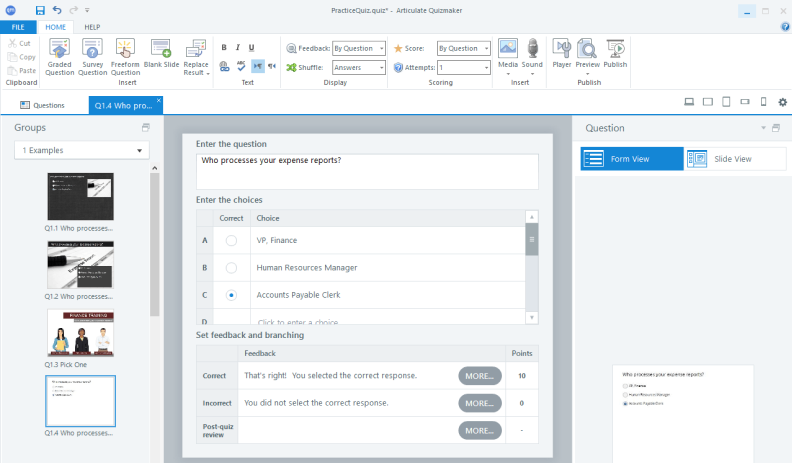
Articulate Storyline 360 is one of the top corporate learning tools today. It specializes in enhancing the level of interaction in online courses through its top-notch content generation features, such as:
- Characters. Make lessons even more relatable by including characters that can build scenarios.
- Content Library 360 integration. This lets you access lots of resources you can use when building your courses.
- Review 360 integration. With this integration, you’ll be able to gather feedback from stakeholders once you’ve completed the course. This way, you can get a few more sets of eyes on the course before your learners see it.
If your business wants to facilitate employee learning through homegrown online course providers and developers, Articulate Storyline 360 might be a good match.
Price: Available through retailers

Adobe Captivate is one of your options for training and development software tools, and it can help you easily develop content to bridge any existing skill gaps for learners. Unlike its predecessor, Adobe Captivate Classic, this version is much easier to use. Here are a few things that you’d love about this solution:
- User-friendly interface. Even if you’re a beginner, you can easily take advantage of creating interactive learning experiences and select from a wide range of design and animation options.
- Feedback mechanisms. If there are multiple people involved in the course creation process, collaboration will come easily as well. They will all be able to view the content in both desktop and mobile formats and leave comments with their suggestions.
- Widget gallery. These can make your lessons more interactive through image carousels, hotspots, and more. Getting them into your course content is as easy as dragging and dropping.
With these features, you can create a solid training and development solution — even with minimal technical know-how.
Best Learning Management Systems (LMSs)
Price: Upon request
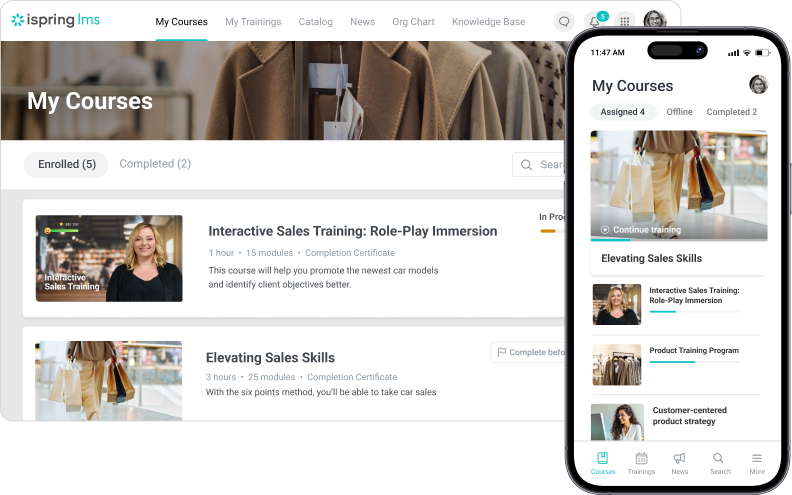
If you’re looking for training and development tools that you can use for every aspect of the training process, then iSpring LMS is a must-have. From onboarding new hires to providing refresher training, this LMS solution can be your go-to platform.
This is made possible thanks to the many features it has in its user-friendly interface. You can access training and development features and capabilities, such as:
- Learning tracks that guide employees through the series of courses they have been assigned and in which order.
- A native content authoring tool that lets you create simple courses and quizzes in your web browser.
- Integration with iSpring Suite AI, which lets you make advanced and interactive training content using PowerPoint.
- A reporting system that lets you manage and monitor the effectiveness of your training programs, as well as each learner’s progress.
- Integration options with HR systems, course marketplaces, and communication tools like Zoom and Teams.
- A mobile app that empowers learners to take learning wherever they are, even without an internet connection.
- Gamification features like badges, points, and leaderboards that keep learners engaged and motivated.
24/7 customer support gives you access to iSpring engineers if you have questions or issues about the LMS.
Experience the full range of its features with a fully functional 30-day trial.
Price: Starts at $119 USD/month for up to 40 users.

TalentLMS is a training platform that has everything you would expect from a training management system. This includes:
- A built-in creation tool that lets you create course content that is complete with assessment measures.
- eCommerce features that help users profit from the created content. Because of this, TalentLMS may be a better option for independent course creators.
- Integration capabilities for tools that you might already be using, like Salesforce, Zoom, and GoToMeeting.
What makes this one of the great training and development software tools available today is how easily it integrates all these capabilities. It’s so user-friendly that you can actually get started with just a few clicks.
Price: Upon request
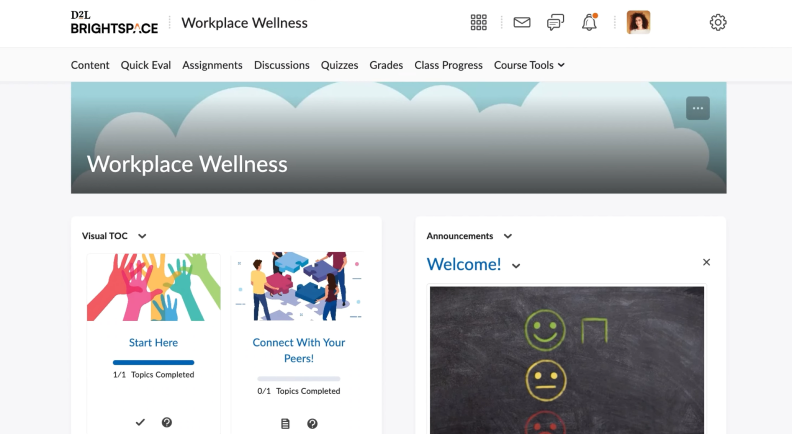
D2L Brightspace is a SaaS/cloud platform that offers several training methods, including in-person learning. This L&D platform ranks high in terms of accessibility, which makes it a good choice for nonprofit organizations. D2L Brightspace has task-specific add-ons like Creator+ or Performance+ that empower users to benefit from the expanded functions.
- Creator+ is an add-on that simplifies content creation. By using templates, educators can develop dynamic course experiences faster without the need for interactive design know-how.
- Performance+ has four dashboards that give users insight into ROI metrics, employee engagement rates, individual learning metrics, and scores.
While D2L Brightspace doesn’t provide support, the company has made efforts to create a themed eLearning community where users can exchange advice and troubleshoot issues that arise.
Price: Upon request

Valamis is one of the best training and development systems if you want the option to market your training content within the platform itself. Another benefit is expanding the learning content because you don’t have to stick with the training courses that the company created and can add your own content to their pre-made courses.
With the use of an AI algorithm, your employees will always see relevant course content based on the established learning goals, as well as their preferences.
Price: Upon request
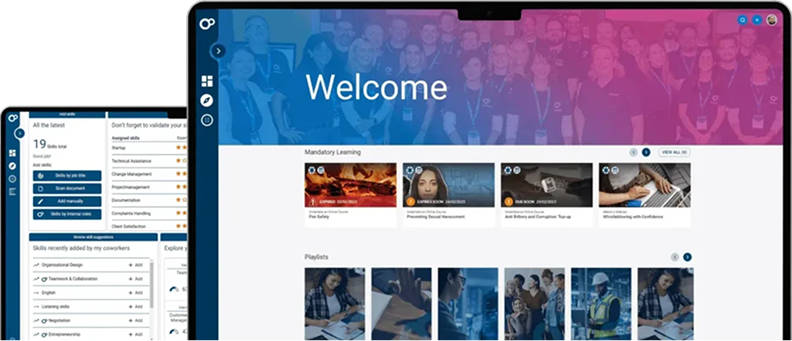
Stream LXP is a training solution from Learning Pool, offering you a series of online learning functions to help employees become more proficient workers. Learning materials are never more than a click away, thanks to the deep search and recommendation capabilities that always put the learner first in relevant learning modules.
If you want software for training and development that offers reduced versions of more comprehensive features that you’d find in LMSs, you’ll love the fact that it also supports simple content authoring and gamification.
Price: Upon request
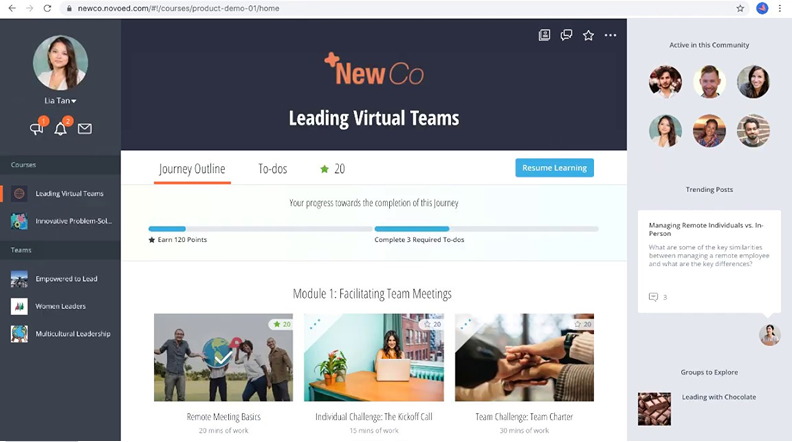
NovoEd understands the value of collaborative learning. That’s why, on top of the standard features that you’ll see in L&D solutions, NovoEd also supports various social learning features and gamification capabilities. These include providing points for finishing modules, discussing their content, and creating collaborative projects in private workspaces.
Best Micro-learning Platforms (MLPs)
Price: $720 USD/month per author/year

If you’re looking for cloud-based L&D tools that let you create training courses, the AI-enhanced iSpring Cloud tool should be at the top of your list. Working with it is as easy as creating a post for Facebook. You can:
- Create course outlines with AI or by yourself.
- Write the course text yourself or generate it with AI while keeping the formatting.
- Add media or generate interactions.
- Make a quiz to assess your learners.
- Invite team members to work together.
- Translate courses with the help of AI.
With its modern, user-friendly interface, it really is that simple. If you have an entire team to help you before the course launches, you’ll be pleased to know that iSpring Cloud also allows collaboration. Multiple people can make edits in real time; one person could be writing while others add graphics.
Price: Upon request
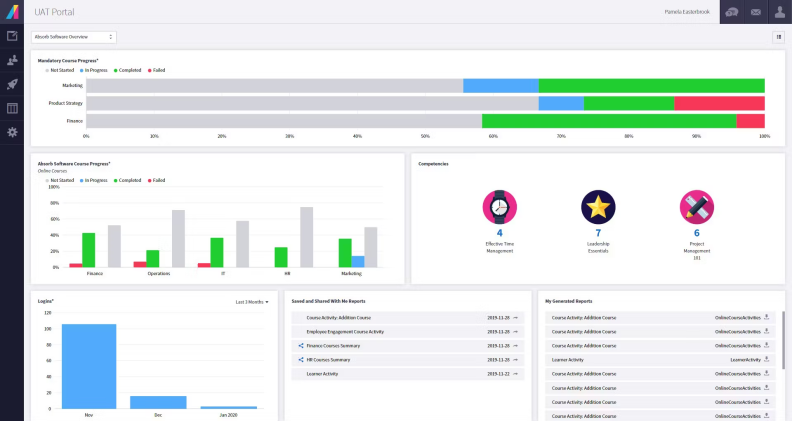
The Absorb LMS offers a large, rich, and varied content library, allowing learners to discover skills one lesson at a time. It covers all the essentials, enabling small to medium-sized companies to stay compliant with industry regulations and standards.
The basic version, Absorb, comes with 500+ curated courses. But if your learners prefer to work in a language other than English, you’ll need to upgrade to the Amplify plan.
Price: Free basic plan for up to 10 learners. Paid plan starts at $5 USD/learner/month.

SC Training is a highly scalable micro-learning tool. From onboarding your employees to certifying your team, SC Training has got your back! Currently, there are over 1,000 interactive learning content items in their course library that you can make accessible to your employees. You can deliver them as is, but you can also white label them to make the courses seem like they are your own.
And if you wish, you can easily make some courses using their templates. There’s also an AI assistant that can make courses for you with a click.
Best Virtual Instructor-led Training (VILT) Tools
Price: Starts with a free plan. The paid plan starts at $4 USD/user/month.

Microsoft Teams brings remote workers closer. Using this tool, participants can do more than just see each other on the screen. They can also use emojis to show learner sentiment and enhance understanding during the discussion.
If you’re holding a large meeting, you’ll be glad to know that Microsoft Teams can accommodate up to 1,000 participants. Meanwhile, as many as 20,000 users can view the meeting live or watch the recording.
To document the discussion during the videoconference, you can transcribe everything and download the transcription afterwards. Another useful feature is the digital whiteboard, which facilitates collaboration through projects and drawings.
The good news is that iSpring LMS supports integration with Microsoft Teams, which makes online collaboration even easier.
Price: Free plan available. Paid plan starts at $13.50 USD/license/month.
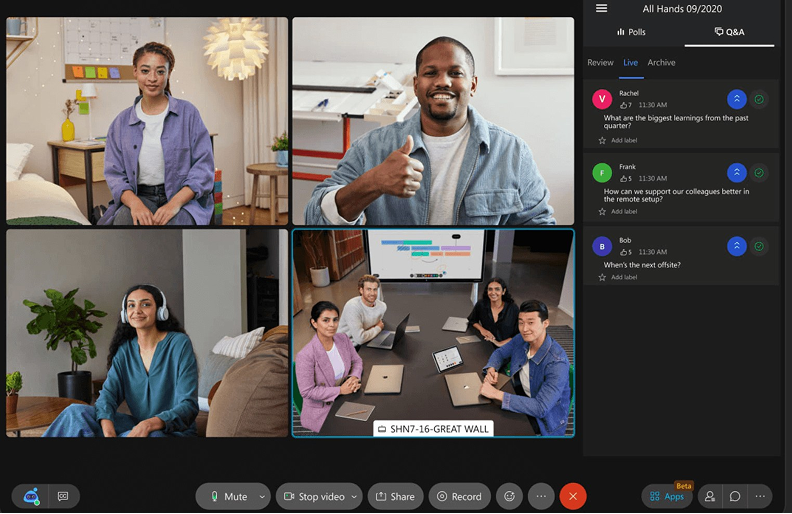
If many users need to be online for any form of online learning, WebEx is a tool that you can rely on. Unlike many L&D solutions, this one is highly flexible, providing different pricing plans for everything from simple meetings to large-scale online conferences. But regardless of your needs, you’ll benefit from the noise reduction capability, which limits distraction while a learning session is in progress.
The Best Communication Tools
Price: Free plan available. Paid plan starts at $8.25 USD/user/month.
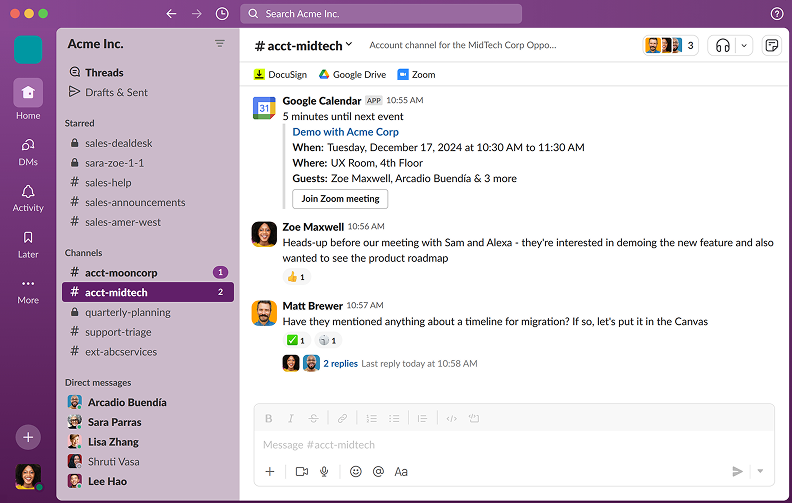
Slack may market itself as a productivity tool, but it’s actually more of a messenger app made for the corporate setting. One of the reasons it remains so popular is that it safeguards data privacy to ensure that all information relayed through its channels is always safe and encrypted.
Price: upon request

Workplace is a communication tool created by Meta. This is a great option if you want the solution that you’re going to use to seem more organic, mimicking something that they probably already use in their everyday lives. Unfortunately, Workplace will be discontinued in May 2026.
Choosing the Right L&D Tools for Your Company
We’ve shared 16 different training and development tools, but you probably won’t need them all. Picking the right L&D solutions can make or break your training program’s success. Here’s a straightforward way to approach your decision:
Step 1: Identify the gaps in your L&D technology
Start by reviewing your training goals, the type of learning content you plan to offer, and your learners’ profiles. If you need both full courses and shorter micro-courses, look for tools that support both. Ask yourself:
- What specific skills should employees gain or improve?
- How will you measure the program’s effectiveness?
- How will you assess your learners’ needs, factoring in their roles, goals, and aspirations?
Clarifying these points will help define your objectives and desired results.
Step 2: Set your budget
Check how much your company can invest in eLearning, including licenses and content creation. Knowing upfront and ongoing costs will help you plan realistically.
Step 3: Test the tools
Once you’ve refined your list, try the options. Many tools offer free trials — make the most of them. Involve some employees to test usability and the relevance of the content to their goals. Whether you want quick, interactive course creation or a full-featured system, something like iSpring Suite AI could be ideal. You can try it free for 14 days and get full access to all the premium features.
FAQ on the Best L&D Platforms
Below, we’ve answered some of the most popular questions about training and development systems:
What are Learning and Development (L&D) tools?
L&D tools are platforms or software solutions that help organizations manage employee training, upskilling, and professional growth. They include platforms for creating, delivering, and tracking training programs, ensuring that learning is not just accessible but also measurable. They may include LMSs, communication tools, micro-learning platforms, and more.
In simple terms, these tools give companies the digital infrastructure to build a culture of continuous learning.
What types of Learning and Development tools exist?
Effective L&D systems usually combine several tool types like Learning Management Systems (LMSs), course authoring tools like iSpring Suite AI, and analytics and reporting tools. Together, these L&D tools form an integrated ecosystem that supports every stage of continuous learning, from creation to impact measurement.
Why are learning and development tools important for businesses?
L&D tools play an essential role in business development:
- They directly impact a company’s performance. By making training programs more efficient and data-driven, they improve productivity, increase knowledge retention, help teams master new skills faster, and ensure consistent quality across departments.
- They support talent retention. When employees see opportunities for professional growth, they’re more likely to stay and contribute long-term. A well-implemented L&D strategy helps businesses to attract and keep top talent.
Why are mobile app versions of training and development solutions important?
With apps, learners can access course content conveniently using the device that’s most suitable for them. It also allows them to learn at the pace they’re most comfortable with.
How do L&D tools support engagement and retention?
Modern L&D platforms use features like gamification, social learning, and personalized learning paths to keep employees motivated and invested in their learner progress. Interactive elements and social learning features add a sense of achievement, while discussion boards and communities make learning collaborative. Interactive learning materials are available with most authoring tools.
Personalization is an essential part as well. Personalized courses create a more meaningful learning experience. As a result, businesses get higher employee engagement, stronger knowledge retention, and employees who feel valued and supported in their development journey.





